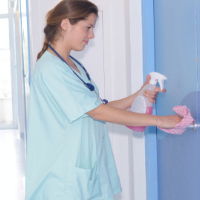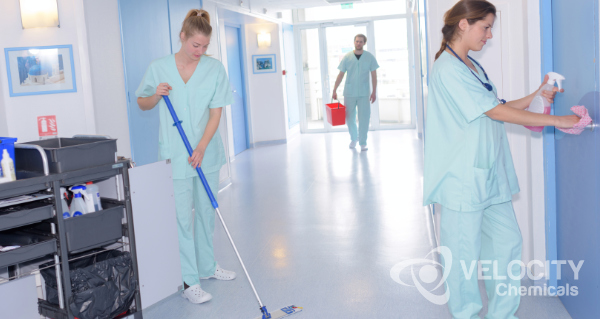How To Maximize Your Disinfectant Supply During The COVID19 Crisis
 The pressure to ensure safe healthcare environments during the COVID19 crisis has heightened demand for cleaners and disinfectants. But with it has come a strain on stocks. How can hospitals, nursing homes and orthopaedic centres maximize their disinfectant supply despite enhanced cleaning frequencies? There are some steps to do so.
In the COVID19 pandemic, running short of disinfectant supplies is not an inconvenience; it could cost lives. The reality of that threat is clear, with the National Institute of Aging, a staggering 82% of COVID19 deaths in Canada occurred in nursing homes.
Healthcare facilities have always had rigorous cleaning regimes to ensure the safest possible environment for residents and staff members alike. And given the ease with which novel coronavirus can spread, those cleaning and disinfection practices have been enhanced.
Simply keeping sufficient disinfectant supplies to hand has become almost as big a challenge, but there are some steps that can help conserve supplies.
The pressure to ensure safe healthcare environments during the COVID19 crisis has heightened demand for cleaners and disinfectants. But with it has come a strain on stocks. How can hospitals, nursing homes and orthopaedic centres maximize their disinfectant supply despite enhanced cleaning frequencies? There are some steps to do so.
In the COVID19 pandemic, running short of disinfectant supplies is not an inconvenience; it could cost lives. The reality of that threat is clear, with the National Institute of Aging, a staggering 82% of COVID19 deaths in Canada occurred in nursing homes.
Healthcare facilities have always had rigorous cleaning regimes to ensure the safest possible environment for residents and staff members alike. And given the ease with which novel coronavirus can spread, those cleaning and disinfection practices have been enhanced.
Simply keeping sufficient disinfectant supplies to hand has become almost as big a challenge, but there are some steps that can help conserve supplies.
1. Apply A Two-Step Cleaning Method
It might seem illogical that a two-step cleaning regimen would help to conserve supplies, but ‘cleaning’ and ‘disinfecting’ are actually different.
Cleaning relates to the removal of visual dirt and grime, and a percentage of the germs with it. Disinfecting, on the other hand, is the killing of these germs, thus making a surface hygienically safe.
Many cleaning products – particularly multi-purpose cleaners – both clean and disinfect in one go. However, these cleaning products are not scientifically proven to be effective disinfectants against dangerous viruses like coronavirus, influenza and norovirus.
A second stage using a powerful disinfectant is the only way to make sure the surface is safe.
2. Clean More Frequently, Disinfect Periodically
With cleaning is effective in removing dirt and germs, there is every reason to have confidence in its contribution to a clean healthcare facility. An increase in the frequency of cleaning can be highly effective in establishing the necessary level of hygienically clean, but that frequency does not necessarily have to be matched when it comes to disinfecting.
Disinfecting can be done more often in areas of high traffic, with individuals periodically using liquid alcohol hand sanitizers (such as Velocity Chemical’s FORTRESS) to disinfect their hands, which Swiss and German research has confirmed are effective in killing novel coronavirus.
3. Target High-Touch Points
A third option to help conserve supplies of disinfectant is to focus on disinfecting high-touch points. These are the areas in which the highest level of traffic is experienced, or locations where surfaces are touched most often over the course of the day.
These are the highest risk areas since they are where COVID19 is most likely to spread through touch. Low-touch points will be cleaned as part of cleaning procedures, but disinfecting frequency there can be reduced.
High-touch points can vary depending on the type of facility, but generally the most common points are those handled and touched almost without thinking by staff and residents.
These can typically include:
-
- In the office – door handles and knobs, handrails, light switches, office equipment, elevator buttons
- In restrooms – sink tap handles, hand dryer, paper dispenser, cubicle doors
- In waiting rooms, lounges or breakrooms – tables and chairs, vending machine (buttons), kitchenette countertops, fridge, oven and microwave doors and handles, kitchen appliances (handles)
- In residents’ rooms and wards – tables, chairs, medical equipment, bed rails, wheelchairs, restroom features

Do Not Increase Dilution Ratios
When conserving supplies, it might be tempting to increase the dilution ratio to make the disinfectant last longer – but this would be a mistake. The efficacy of any chemical disinfectant is dependent to the dilution ratio, and any change can ultimately undermine disinfection efforts.
Velocity Chemical’s VELOSAN, for example, has a recommended dilution ratio of between 64mls and 100mls per 900mls of water if maximum effectiveness is to be achieved. Anything less than 64mls is will result in a weaker fluid that is likely not to be effective at all.
Velocity Chemical FORTRESS
FORTRESS liquid alcohol hand rub topical cleanser kills harmful and disease-causing germs on contact. It is used for personal hand hygiene to help cleanse hands when water and soap are not readily available.Made in Canada, FORTRESS is already a trusted name as it has been used by industrial and commercial establishments for years. It contains the recommended 60% alcohol to safely kill pathogens, ensuring personal hand hygiene at home, in break rooms, meeting rooms or over transaction counters.
Available in 4 L jugs and 20 L pails, FORTRESS is available from our approved distributors and directly from Velocity Chemicals, with orders shipped to anywhere in Canada within 24 hours.
For more information, call one of our experts Toll-Free on 1-888-963-9499
Tags: Covid-19, Disinfectant Supplies, Healthcare facilities




